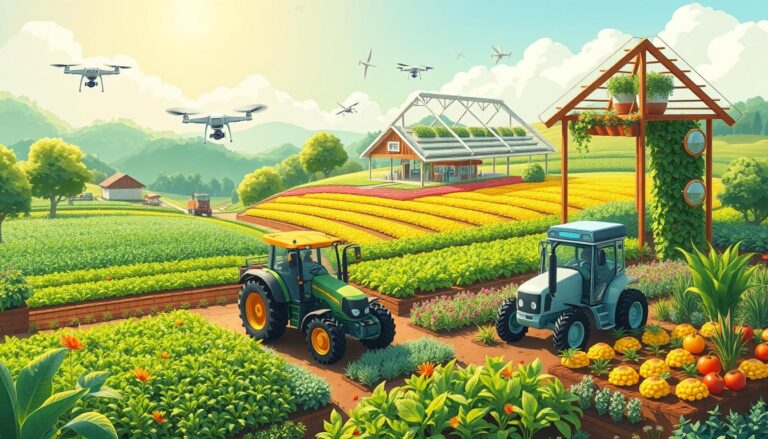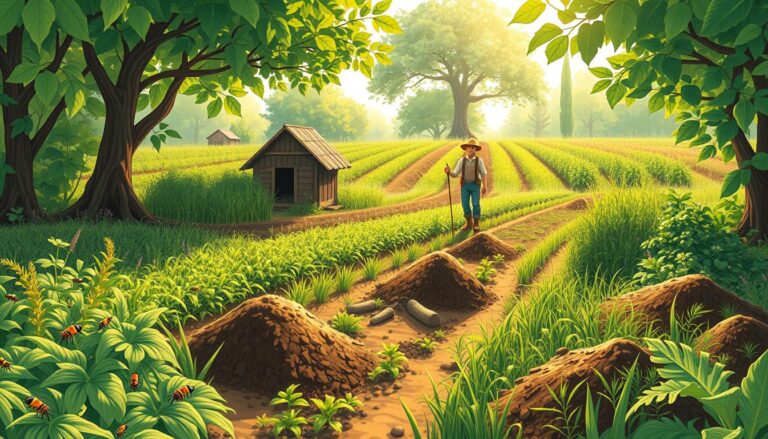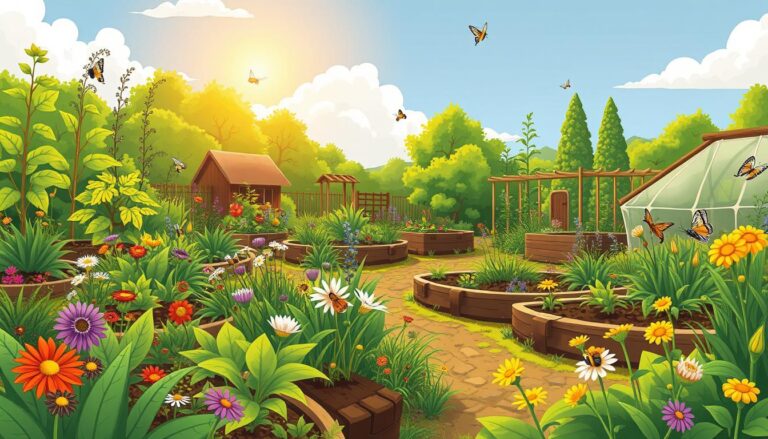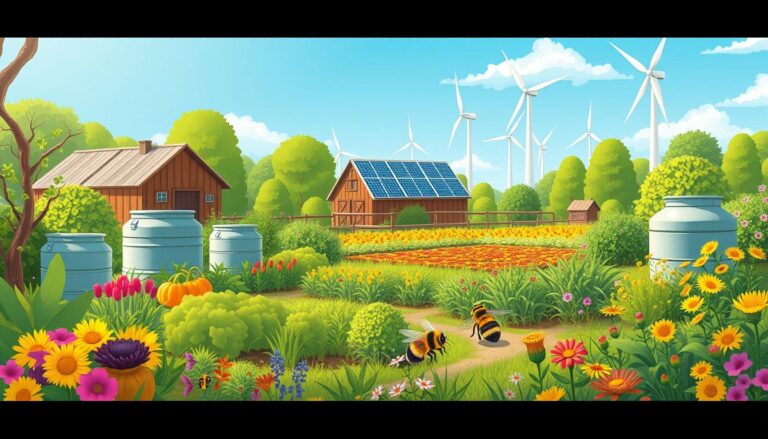Energy-efficient greenhouse design
Energy-efficient greenhouses are key in sustainable agriculture. They use cost-effective methods and passive solar heating. This creates the best growing conditions while using less energy. These greenhouses also help lower utility bills and reduce carbon emissions.
Energy-efficient greenhouses have special features. They use the right materials for the structure and covering. They also have efficient heating, cooling, and ventilation systems.
Good insulation and preventing air leaks help keep temperatures stable. Using LED grow lights instead of traditional HPS lamps can save a lot of energy.
When designing an energy-efficient greenhouse, consider its orientation, location, and renewable energy use. Working with experts and using data can make the design more efficient. This approach saves money, improves plant health, and is better for the environment.
Key Takeaways
- Energy-efficient greenhouses minimize energy consumption while creating optimal growing environments
- Proper insulation, leak prevention, and efficient heating, cooling, and lighting systems are crucial
- LED grow lights can save up to 70% of energy compared to HPS lamps
- Consulting with professionals and utilizing data-driven analysis can optimize greenhouse design
- Energy-efficient practices lead to cost savings, improved plant health, and a reduced carbon footprint
What is Energy-efficient Greenhouse Design?
Energy-efficient greenhouse design aims to create a perfect environment for plants while using less energy. This approach helps reduce environmental impact, lower bills, and improve plant health.
Energy-efficient greenhouses use sustainable practices and advanced technologies. They work together to make growing plants more sustainable and affordable.
Definition and Importance
Energy-efficient greenhouse design means making greenhouses that use less energy but still support plant growth well. It’s key because it:
- Reduces environmental impact
- Lowers utility costs
- Improves plant health and growth
- Supports sustainable growing
Key Features of Energy-efficient Greenhouses
Energy-efficient greenhouses have special features that help them perform well and sustainably:
- Orientation and Location: The right spot and direction can help get more natural light and use less energy for heating and cooling.
- Materials Used in Construction: They use materials like polycarbonate panels or ETFE glazing. These materials let in lots of light but keep heat in.
- Insulation Techniques: Good insulation, like reflective panels or energy curtains, keeps temperatures steady and saves energy.
| Glazing Material | Light Transmission | Warranty |
|---|---|---|
| Polycarbonate (8mm) | 81% | 10 years |
| Polycarbonate (16mm) | 65% | 10 years |
| ETFE | 95%+ | – |
By using energy-efficient features and technologies, growers can cut down on environmental harm and costs. They also help plants grow better.
Benefits of Energy-efficient Greenhouses
Energy-efficient greenhouses bring many benefits to growers. They help cut down on energy use and support a greener future for farming.
Cost Savings on Utility Bills
One big plus of energy-efficient greenhouses is saving money on utility bills. They use better insulation to keep temperatures steady, which cuts down on energy use. LED lights also use less energy for lighting up the greenhouse.
DryGair is a system that lowers energy use by controlling humidity. It doesn’t need ventilation. This tech boosts energy efficiency and saves water by reusing air water.
Reduced Carbon Footprint
These greenhouses also help reduce carbon emissions. They use less energy and green tech, making farming more eco-friendly.
As energy costs go up, growers are more likely to use energy-saving tech. This not only saves money but shows their dedication to the environment.
Enhanced Plant Health and Growth
Energy-efficient greenhouses offer the best conditions for plants. They keep temperatures and humidity just right, helping plants grow strong and healthy.
The Boulder, Colorado, research greenhouse is a great example. It’s small but kept plants warm on cold nights and cool on hot days. This allowed for growing many types of vegetables.
| Conventional Greenhouse | Energy-efficient Greenhouse |
|---|---|
| Annual energy bills: $15,000 | Reduced energy bills |
| Winter gas consumption: 1200 million Btu | Lower gas consumption |
| Poor insulation (R value) | R-20 extruded polystyrene insulation |
| Lack of thermal mass | Improved thermal mass |
Conventional greenhouses in Lyons, CO, spend $15,000 a year on energy and use a lot of gas in winter. But, energy-efficient greenhouses with better insulation and thermal mass are more affordable and sustainable.
Essential Elements of Design
Creating an energy-efficient greenhouse requires careful planning. You need to think about the structure’s orientation, the materials used, and insulation techniques. These elements help maximize sunlight, reduce heat loss, and keep a stable environment for plants.
Orientation and Location
The greenhouse’s orientation and location are key to its energy efficiency. Positioning it to catch more sunlight and avoid harsh winds helps. Consider the sun’s path, wind directions, and nearby structures when choosing the best spot.
- The path of the sun throughout the day and across seasons
- Prevailing wind directions and speeds
- Surrounding buildings, trees, or other structures that may cast shade or create wind tunnels
Materials Used in Construction
The materials you choose greatly affect the greenhouse’s energy efficiency. Popular options include:
| Material | Pros | Cons |
|---|---|---|
| Glass | Maximum light transmission, retains heat well, durable, recyclable | Higher cost, heavier, requires stronger structure |
| Twin-wall polycarbonate | Lightweight, good insulation, impact-resistant, UV-protected | May yellow over time, lower light transmission than glass |
| Polyethylene film | Cost-effective, lightweight, easy to install | Reduced wind and snow resistance, requires frequent replacement |
When picking materials, think about cost, durability, light, and insulation. Thicker panels are stronger but cost more.
Insulation Techniques
Good insulation keeps temperatures stable and reduces heat loss. Effective techniques include:
- Installing thermal screens or curtains to reduce heat loss and maintain temperature
- Using weather stripping around doors and vents to minimize air leaks
- Insulating the greenhouse foundation to prevent ground cold from affecting the interior
- Implementing double-glazing or bubble insulation to improve the insulating properties of the greenhouse covering
Quality insulation helps create a stable growing space. It also cuts down on energy use and costs.
Reusing materials and repurposing items in greenhouse construction can help reduce waste and promote sustainability while providing cost-effective solutions.
Renewable Energy Solutions
Using renewable energy in greenhouses is a smart move. It cuts down on fossil fuel use and lowers energy bills. Greenhouse owners can tap into the sun, wind, and earth’s power. This makes their growing space more eco-friendly and sustainable.
Solar Power Integration
Putting solar panels on the roof is a great way to get electricity. Solar thermal systems can turn 60% to 70% of sunlight into heat. This makes them very good at warming greenhouses.
Solar panels can also turn about 20% of sunlight into electricity. This is a cheap and green way to power things.
Wind Turbine Options
Wind turbines come in sizes from 25kW to 95kW. They can power farms that run on electricity, especially at night. A big greenhouse of about 3000 sq ft might need 400 kWh of battery power each night.
Other Sustainable Energy Sources
Geothermal heating, biomass boilers, and fuel cells are also good for greenhouses. Fuel cells can make electricity from sunlight with an efficiency of 35%. This is almost twice as good as solar PV panels.
Bio-digesters make biogas from organic stuff. They’re great for big commercial projects.
| Energy Source | Efficiency | Application |
|---|---|---|
| Solar Thermal Systems | 60-70% | Heating |
| Solar Panels | 20% | Electricity |
| Fuel Cells | 35% | Electricity |
| Bio-digesters | Varies | Heat and Power |
Greenhouse owners can make a big difference by using renewable energy. They can lower their environmental impact, save money, and help make farming more sustainable.
Tips for Optimizing Greenhouse Efficiency
Improving greenhouse efficiency is key to saving money, reducing environmental harm, and growing healthy plants. By using smart strategies, growers can make their greenhouses more sustainable and productive. Here are some ways to boost your greenhouse’s efficiency:
Climate Control Strategies
Keeping the right growing conditions is vital for plant health and saving energy. Temperature regulation is a big part of managing a greenhouse. Using shade cloths, ventilation, and cooling can control temperatures and prevent overheating. Sealing leaks and adding insulation also cuts down on energy loss.
Thermal, shading, and blackout screens help keep energy in by reducing heat loss. Dehumidifiers also play a role in keeping the greenhouse at the right humidity.
Water Conservation Techniques
Water is very valuable, and saving it in greenhouses is important for the environment and saving money. Using irrigation systems like drip irrigation can cut down water use while still watering plants well. Collecting rainwater is another smart move, letting growers use it later.
These water-saving methods help avoid wasting water and lower bills.
Smart Technology and Automation
Precision agriculture technologies have changed how we manage greenhouses. Smart sensors, controllers, and apps let growers keep a close eye on their greenhouse. These tools adjust things like temperature, humidity, and light based on current data, ensuring the best growing conditions while using less energy.
Automation also cuts down on labor costs and lets growers check on their greenhouse from anywhere, making things more efficient and easy.
“Greenhouse monitoring technology can help growers optimize resource usage, leading to increased energy efficiency.”
Here are some interesting facts to keep in mind when improving your greenhouse:
- Using efficient lighting, like LEDs, can save up to 90% of energy compared to old bulbs in greenhouses.
- About 58% of CEA producers and partners use good modeling practices for their facilities, while 25% use better ones.
- Grants like REAP (Rural Energy for America Program) can help farmers save energy by funding greenhouse upgrades.
By using climate control, water-saving methods, and smart tech, growers can greatly improve their greenhouse’s efficiency. Keeping up with new tech and doing regular maintenance is key to long-term success and profit in greenhouse farming.
Real-world Examples and Case Studies
Energy-efficient greenhouses are making a big impact. Kuehnle Farms in Hawaii uses hydroponics and vertical farming to grow more with less energy. They also have solar panels and energy-saving lights, cutting down on costs and carbon emissions.
Successful Energy-efficient Greenhouses
Sundrop Farms in Australia is another success story. They use the sun and seawater to power their greenhouse. This makes their farm eco-friendly and self-sufficient, growing crops all year. Their success is inspiring others to follow their lead.
Lessons Learned and Best Practices
Studies on greenhouses teach us a lot. To succeed, you need a good plan, regular upkeep, and always look for ways to improve. Using new tech like AI and robots can also boost your greenhouse’s performance. By following these tips, growers can make their greenhouses more efficient and productive.
Future Trends in Greenhouse Sustainability
The future of greenhouses looks bright. We’ll see more use of clean energy like solar and wind. Smart sensors and automation will help control growing conditions better. These advancements will make greenhouses even more important for growing food sustainably.
Source Links
- Efficient Greenhouse Design – Greenhouse Product News
- Energy Efficient Greenhouse – Designing a Greenhouse (Feat. Hortinergy)
- Things a Greenhouse Grower Can Do To Improve Energy Efficiency
- Solar Greenhouse – Growing Spaces Geodesic Greenhouse Kits
- Net Zero Greenhouses – Zero Energy Greenhouses
- Exploring the Potential – ATTRA – Sustainable Agriculture
- Greenhouse Energy Efficiency – Explanations and Improvements – DryGair
- Energy-Efficient Greenhouse Breakthrough
- The Essential Elements of a Gardening in Greenhouse
- Considerations When Designing and Building a Research Greenhouse
- 6-Step Guide to Designing and Creating a Sustainable Greenhouse | GBB°
- Electric Greenhouses Are The Future: A Guide To Utilizing Renewable Energy Sources And Energy-Efficient Design For Sustainable Growing
- Greenhouse energy efficiency and renewable energy integration – Kryzen
- Optimizing Greenhouse Designs for Efficiency and Cost
- Energy Efficiency: 6 Tips For Greenhouse Energy Savings – DryGair
- 5 Strategies for Maximizing Your Commercial Greenhouse Efficiency in Winter
- Designing a Solar Greenhouse: Combining Sustainability with Agriculture
- Greenhouse Climate Control Systems: Crop Yield with Centrifugal Fans
- Optimizing Greenhouse Design with Miniature Models and IoT (Internet of Things) Technology—A Real-Time Monitoring Approach







